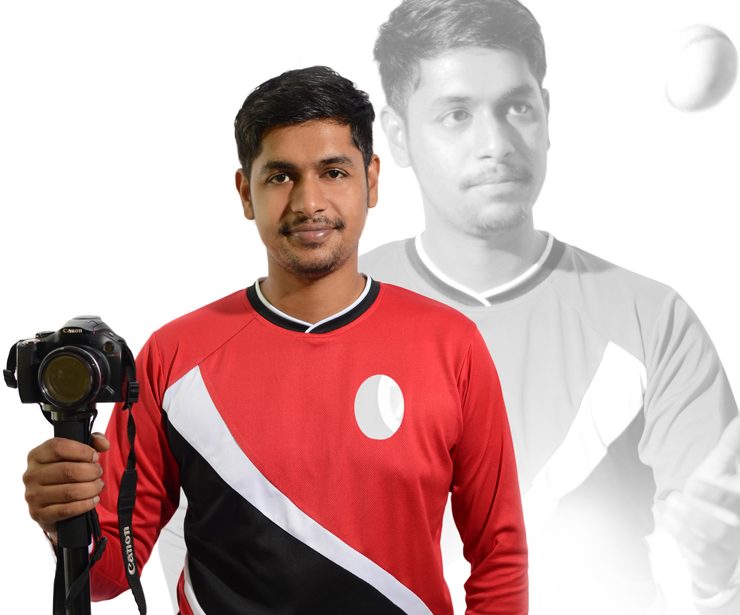The sport of cricket immediately calls to mind our nation’s famous batsmen and bowlers… but what about the rest of the team behind the scenes?
Dinesh Mahabir is one of these invaluable team members.
As the Analyst of Trinidad and Tobago’s national cricket team, he pulls double duty as a video analyst — reducing each movement frame by frame to determine any flaws in technique and execution.
This is called “biomechanics”.
Laws of mechanics and physics to human performanceIn the context of sport, biomechanics is the sport science field that applies the laws of mechanics and physics to human performance, in order to gain a greater understanding of performance in athletic events through modelling, simulation and measurement.
This practice has gradually increased in popularity around the world over the last few decades in many sports, but it is still fairly new to Trinidad and Tobago and the wider Caribbean. In Trinidad and Tobago, it has been used for just about five years, and Dinesh was one of the first to begin integrating it into his coaching practice.
The most economical way to get the best result“The first priority is to make sure the players are being safe — as certain kinds of movements can damage parts of their bodies,” says Dinesh.
“Next, we can look towards improvement: by being able to calculate a benchmark, we can determine the speed of a batsman or bowler, and see the most economical way to get the best result of every twist or turn that comprises the entire move.”
A Passion for Cricket & Film
Dinesh has been involved with cricket since he was a young boy, and played for youth clubs at the national level.
Two passions: cricket and filmHe holds a Bachelor’s degree in Marketing, but has always gravitated to two passions: cricket and film. He also works part-time in film editing and production, for international clients as well as for his own personal projects.
“I was doing biomechanical video analysis before I really even knew what that was,” he says. “I would carry a camera to matches or record directly from TV, and film them just to be able to look back and determine what went right or wrong in a particular move.”
He credits Kelvin Williams, Trinidad and Tobago’s former national cricket team’s Head Coach, who was at the helm at the time that he came on board and recognised biomechanics as he saw the immense value it could bring.
A course in video analysis specific to the sport of cricketAs Dinesh became more involved in it, he took an opportunity to travel to England to do a course in video analysis specific to the sport of cricket. He is also a Cricket Australia High Performance Coach, allowing for coaching and analysis to go hand in hand.
For the last five years, he has worked locally as well as toured internationally with our national cricket team, on a part-time or ad-hoc basis when contracted by the Trinidad and Tobago Cricket Board (TTCB). This year is the first that he has been employed full-time with the Board, which is testament to the value he has brought to the team’s performance over the past five years.
The Future for Biomechanic Video Analysis
As one of the pioneers in the field in T&T, Dinesh’s skills are in high demand. Despite the hectic nature of his role, he enjoys it thoroughly and is proud of the great strides he has made to integrate video analysis as part of coaching techniques in every aspect of TTCB’s leagues.
“At every youth level, I work with the children, introducing them to working with this kind of technology to improve their skills,” he says. “Every national team now uses it, so once you are under the helm of the TTCB, you will be introduced to it.”
This really helps with the disciplineWhile a video analyst may be a distinct career in some countries, the industry is still under development in T&T, and video analysis is part of the role of the coach or someone else on the staff. In Dinesh’s case, he enjoys the combination of the two, as he believes the analysis lends an extra level of confidence in his coaching style.
“With video, the players can’t fake it, so all the lies and excuses go out the window,” says Dinesh.
“This really helps with the discipline, as it allows players to really see where they are going wrong, and then they can come back and forth to the screen to compare their performance on one occasion to another day’s performance. It’s about learning how you function as an athlete.”
Video analysis is crucial for any kind of sportHe notes that other countries have an edge because they have been practicing biomechanic analysis for decades, while Trinidad and Tobago is still catching up to the international standards in coaching practices. However, the future looks promising.
The TTCB has recently outfitted a few rooms at the National Cricket Academy in Couva, central Trinidad, for biomechanic video analysis, where Dinesh works with players to improve their skills.
“My goal is that if and when I leave this role, there are pathways for others to do it if they are interested,” he says.
“Video analysis is crucial for any kind of sport, and it has done a world of difference for cricket around the world. I want to make sure that, in T&T, this analysis is well integrated in our sports, and has a home here.”

